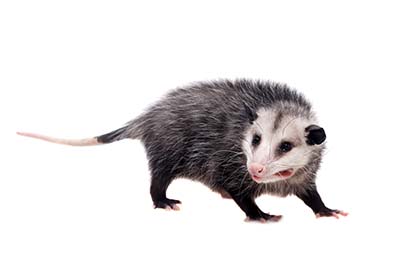Latin Name: Didelphidae

Opossums are medium-sized marsupials originating from North America. They have large ears, long hairless tails, short and stumpy legs with five toes that have an opposable thumb on the front and hind feet. They have a white face, wooly fur with a white undercoat, and guard hairs with varying colors.
They are often called “possums.” Why? No one knows. However, the name became a common term in 1613.
There are at least 60 species of possum, and the most popular is the Virginia possum. They are scavengers but have other remarkable abilities that help them find, keep and remember where they keep their food.
Opossums have long tails, large, hairless ears, and pointed snorts. They are typically grey in colors. However, some of them have varying shades like red or brown. They also have a greyish look because of the long, white-tipped guard hairs on their thick fur. It acts like a raincoat and protects them from snow and rain. They have a long and slender body with a pinkish face. Their hairless tails are like an additional limb that helps them to climb. They have five digits on each foot, where the back foot has a sizeable opposable toe with no claw used for grasping. Sometimes, you will find them with three dark sneaks. Their average size is between 21 – 36 inches long, and they weigh about 4 – 15 pounds.
They prefer to live in bushy or forested habitats, including urban areas as long as it is dry, safe, and sheltered. Opossums don’t build their own houses but live in holes dug by other mammals, i.e., woodpiles, crevices, hollow stumps, and spaces under buildings. They fill their dens with dried grass, leaves, and other materials to keep the place warm. Many times, you will find them around woodlands with nearby sources of water like swamps. They easily thrive in varying climates and habitats. All opossums need to survive are food, shelter, and water.
Opossums eat all kinds of food, from grasses, fruits, mammals, fish, birds, and insects. They also love to keep rats and cockroaches at bay since they compete in the same territory. Generally, their menu includes rodents, dead mammals, fruits, grains, frogs, and plants. Their diet contains high amounts of calcium. It is also uncommon to find them feeding on dog food, table scraps, cat food, and anything from the garbage cans.
Although Opossums live in solitary and prefer to travel alone, they can cause severe damage to human properties. Some of the signs that show the infestation of opossums are:
Possums transmit diseases to humans and pets, i.e., tuberculosis, spotted fever, coccidiosis, tularemia, leptospirosis, etc. They also create several problems for homeowners because they are notoriously known for sneaking into the yard and buildings undetected. When they enter the yard, they knock over garbage cans to feed on waste; they also tamper with unattended pet food and other chaos.
It can be challenging to remove opossums from your home; hence it is better to prevent their activities. The wildlife rescue league recommends that homeowners do the following:
If you suspect these pests are in or around your home, give us a call for a Free Home Inspection!
